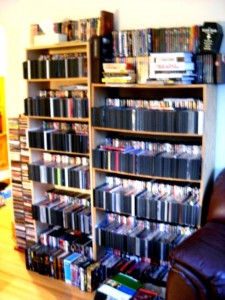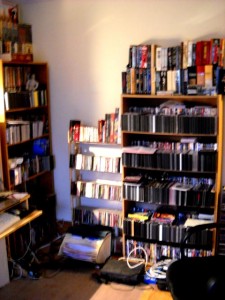DVD Addiction
I’m addicted to DVDs, and like many addicts I’m somewhat ambivalent about my substance of choice.
Back in the day (and I am old enough to use that expression) I got a pleasure out of watching movies that I don’t seem to get so much any more. In some ways this seems strange because in the past ten years DVD has given me access to a vast span of film history which was previously inaccessible to me – I have a collection that probably amounts to close to 7000 titles by now, ranging from the very first movies made in the 1890s to some of the latest releases. My sense of film history has been transformed by this new technology – the myths I grew up with about the primitive nature of early film, about the damage done by the introduction of sound, about the relentless improvements in filmmaking technique as the medium marched bravely into an ever-better future … all these received ideas have been shattered by what I’ve seen in the past few years: the quickly developing sophistication of technique and storytelling art in the first decades of movie-making, the experiments with sound and colour almost from the very start, the radical editing of many silent films, the richness of sound in the early years of the transition (yes, many clumsy, stilted films were made, but in the hands of sophisticated artists sound was quickly revealed as a means to enrich the possibilities of the medium) …
And yet, with all this access that I now have – or perhaps because of it – the pleasure of watching an individual film seems diminished. Things are hyped to the point of absurdity these days, but with diminishing returns. There was a time when I’d read or hear about something that was in the works and my anticipation would build until it peaked with the arrival of the movie in a local theatre; now as often as not the pre-release advertising and publicity have exhausted me to the point where, by opening day, I’ve lost all interest.
I’m drawn to older films much of the time, even minor ones which were probably barely noticed when they were released but now throw some light on the times they were made in – recent Warner and Sony film noir sets, Sony’s on-going releases from their Hammer Films library (Icons of Adventure, Icons of Horror, Icons of Suspense, two sets of Korean films made during the Japanese Occupation of the 1930s and ’40s recently released as The Past Unearthed.
Or even further back, to the ’20s when remarkable things were done with what seem like primitive means compared with the technology we have now – like Keaton’s amazing short Playhouse (1921) in which he plays every character, in some scenes with as many as seven or eight of himself all seamlessly interacting; or the epic camera techniques of L’Herbier in his magnificent dissection of capitalist excess L’Argent (1928). There’s a phenomenal scene in Asquith’s silent A Cottage on Dartmoor (1929) set in a cinema at the dawn of sound, in which through superb camerawork and dynamic editing he shows the wonder of the new medium by focussing entirely on the audience. These are films which were until recently unknown to me, invisible among the standard classics by Murnau and Lang, Chaplin and Griffith …
But it’s perhaps clear from these remarks that what pleasure I now get from watching all these films is not the old visceral thrill of being immersed in the kind of enveloping entertainment offered by movies in the shared darkness of a theatre, but something more intellectual, a little more abstract and distanced, as I accumulate an ever wider store of film historic knowledge.
Back in the day before DVD, before home video of any kind, there was much more limited access to far fewer movies; there was a greater element of chance involved in getting to see more obscure titles. I first heard about George Romero’s Night of the Living Dead in the early ’70s, a review which urged the reader to make every effort to see it if it ever turned up within a hundred miles – well, I actually drove about 120 miles to catch a screening in Winnipeg and it was absolutely worth the effort.
In those days, shows changed in most theatres every week, with a movie occasionally being held over for a second week and if it was really popular, maybe a third or even a forth. But generally, if you wanted to see something you had to go that first week just to make sure … so in the ’70s and early ’80s I’d usually see four or five movies a week. When I lived in a small town outside Winnipeg, I would drive in for a day and see four or five movies in a row (starting about 11:00AM and ending around midnight) before driving home with sore eyes and a headache … but it always seemed worth it.
Barring the chance of a particular movie showing up sometime later on television, you might just get one chance to see it … so you made the effort, went out of your way, and as a result seemed to absorb more. Many of the films I saw back then left indelible memories which still remain, while something I watched on DVD last week might be all but forgotten. Although I now have a virtually complete collection of Mario Bava’s movies, my best experience of his work probably remains the first – seeing Kill, Baby, Kill! (1966) late at night on a small TV with really bad reception which made the images very soft and grainy; it was like seeing the ghost of a movie about a ghost …
I can’t imagine giving up my collection, or no longer scouring the Internet for rare and interesting titles (I just got a copy of Thorold Dickinson’s final feature Hill 24 Doesn’t Answer (1955) from an obscure Jewish organization in the States; just ordered on eBay a copy of an uncut German edition of Lang’s Hangmen Also Die! (1943) from some guy in Scotland; and my collection of titles from the Filmmuseum in Munich is slowly but steadily growing …), yet rather than feeling that each movie that comes my way is a gift to be savoured and absorbed, this vast collection sometimes feels like a burden to be carried, that there’s always a new obligation to acquire and watch something because it has some technical, artistic or historical significance – or simply because it happens to be obscure and there’s an ego thing about owning it and being able to say, oh sure, I’ve seen Die elf Teufel and Konig der Mittelsturmer, the first two feature-length dramas ever made about soccer, released within months of each other in 1927 …



Comments